suspension FIAT DUCATO 2015 Owner handbook (in English)
[x] Cancel search | Manufacturer: FIAT, Model Year: 2015, Model line: DUCATO, Model: FIAT DUCATO 2015Pages: 367, PDF Size: 19.73 MB
Page 2 of 367
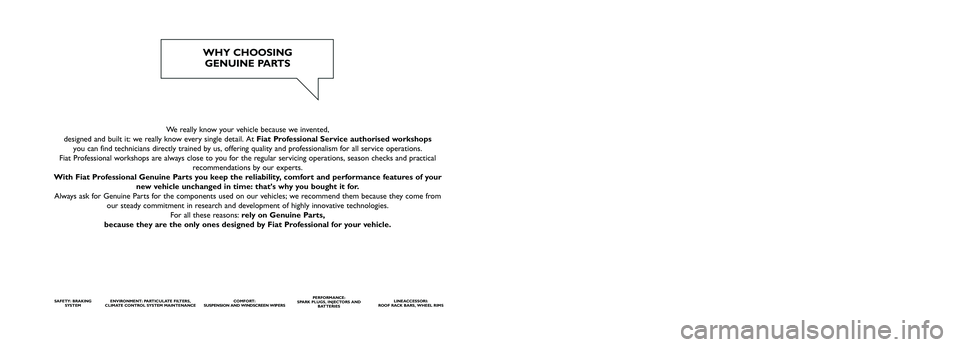
We really know your vehicle because we invented,
designed and built it: we really know every single detail. At Fiat Professional Service authorised workshops
you can find technicians directly trained by us, offering quality and professionalism for all service operations.
Fiat Professional workshops are always close to you for the regular servicing operations, season checks and practical recommendations by our experts.
With Fiat Professional Genuine Parts you keep the reliability, comfort and performance features of your new vehicle unchanged in time: that's why you bought it for.
Always ask for Genuine Parts for the components used on our vehicles; we recommend them because they come from our steady commitment in research and development of highly innovative technologies. For all these reasons: rely on Genuine Parts,
because they are the only ones designed by Fiat Professional for your vehicle.
SAFETY: BRAKING SYSTEMENVIRONMENT: PARTICULATE FILTERS,
CLIMATE CONTROL SYSTEM MAINTENANCECOMFORT:
SUSPENSION AND WINDSCREEN WIPERSPERFORMANCE:
SPARK PLUGS, INJECTORS AND BATTERIESLINEACCESSORI:
ROOF RACK BARS, WHEEL RIMS
WHY CHOOSING GENUINE PARTS
COP DUCATO LUM GB 20/01/14 09.58 Pagina 2
Page 13 of 367
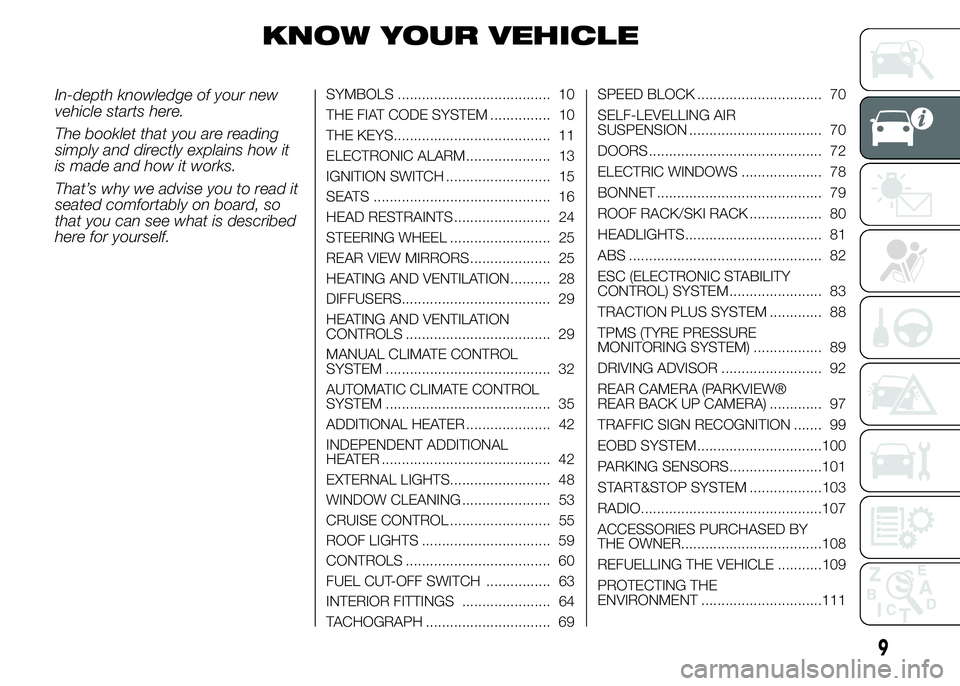
KNOW YOUR VEHICLE
In-depth knowledge of your new
vehicle starts here.
The booklet that you are reading
simply and directly explains how it
is made and how it works.
That’s why we advise you to read it
seated comfortably on board, so
that you can see what is described
here for yourself.SYMBOLS ...................................... 10
THE FIAT CODE SYSTEM ............... 10
THE KEYS....................................... 11
ELECTRONIC ALARM..................... 13
IGNITION SWITCH .......................... 15
SEATS ............................................ 16
HEAD RESTRAINTS ........................ 24
STEERING WHEEL ......................... 25
REAR VIEW MIRRORS .................... 25
HEATING AND VENTILATION.......... 28
DIFFUSERS..................................... 29
HEATING AND VENTILATION
CONTROLS .................................... 29
MANUAL CLIMATE CONTROL
SYSTEM ......................................... 32
AUTOMATIC CLIMATE CONTROL
SYSTEM ......................................... 35
ADDITIONAL HEATER ..................... 42
INDEPENDENT ADDITIONAL
HEATER .......................................... 42
EXTERNAL LIGHTS......................... 48
WINDOW CLEANING ...................... 53
CRUISE CONTROL ......................... 55
ROOF LIGHTS ................................ 59
CONTROLS .................................... 60
FUEL CUT-OFF SWITCH ................ 63
INTERIOR FITTINGS ...................... 64
TACHOGRAPH ............................... 69SPEED BLOCK ............................... 70
SELF-LEVELLING AIR
SUSPENSION ................................. 70
DOORS ........................................... 72
ELECTRIC WINDOWS .................... 78
BONNET ......................................... 79
ROOF RACK/SKI RACK .................. 80
HEADLIGHTS.................................. 81
ABS ................................................ 82
ESC (ELECTRONIC STABILITY
CONTROL) SYSTEM ....................... 83
TRACTION PLUS SYSTEM ............. 88
TPMS (TYRE PRESSURE
MONITORING SYSTEM) ................. 89
DRIVING ADVISOR ......................... 92
REAR CAMERA (PARKVIEW®
REAR BACK UP CAMERA) ............. 97
TRAFFIC SIGN RECOGNITION ....... 99
EOBD SYSTEM...............................100
PARKING SENSORS.......................101
START&STOP SYSTEM ..................103
RADIO.............................................107
ACCESSORIES PURCHASED BY
THE OWNER...................................108
REFUELLING THE VEHICLE ...........109
PROTECTING THE
ENVIRONMENT ..............................111
9
Page 74 of 367

The tachograph is installed and
sealed by authorised personnel: do
not try and access the device or
the supply and recording leads
in any way. It is the responsibility of
the owner of the vehicle on which
the tachograph is installed to check
the device regularly.
The check must be carried out at
least every two years and a test
must be carried out to ensure that it
is working properly. Ensure that
the data label is renewed after
every check and that the
label contains the specified data.SPEED BLOCK
(for versions/markets, where
provided)
The vehicle is equipped with a
speed limitation function that can
be set at the user's request to one
of 4 predefined values: 90, 100,
110, 130 km/h.
To activate/deactivate this function,
contact a Fiat Dealership.
Following the operation, a sticker
will be applied to the windscreen
showing the maximum speed
setting.
IMPORTANT The speedometer
could indicate a higher maximum
speed than the effective one, set by
the Dealership, in accordance with
the regulations in force.
SELF-LEVELLING AIR
SUSPENSION
GENERAL
INFORMATION
The system only acts on the rear
wheels.
The system maintains the rear ride
setting for the vehicle constant in
any loading condition, while
ensuring a greater driving comfort.
In addition, the system allows
the height of the vehicle to
be adjusted with the vehicle
stationary, by selecting from 7
different positions to facilitate
access to the rear compartment.
HEIGHT ADJUSTMENT
There are 7 pre-defined levels for
the free height from the ground:
from “ride -3” to “ride 0” till “ride
+3”.
The multifunction display, located in
the middle of the instrument panel,
can show the ride position.
70
KNOW YOUR VEHICLE
Page 104 of 367
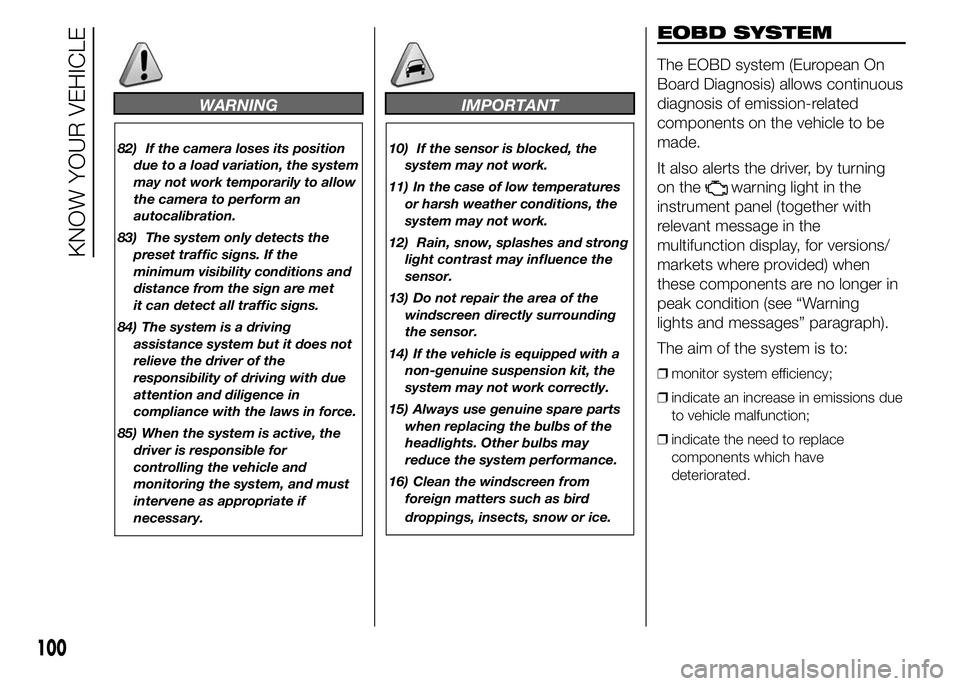
WARNING
82) If the camera loses its position
due to a load variation, the system
may not work temporarily to allow
the camera to perform an
autocalibration.
83) The system only detects the
preset traffic signs. If the
minimum visibility conditions and
distance from the sign are met
it can detect all traffic signs.
84) The system is a driving
assistance system but it does not
relieve the driver of the
responsibility of driving with due
attention and diligence in
compliance with the laws in force.
85) When the system is active, the
driver is responsible for
controlling the vehicle and
monitoring the system, and must
intervene as appropriate if
necessary.
IMPORTANT
10) If the sensor is blocked, the
system may not work.
11) In the case of low temperatures
or harsh weather conditions, the
system may not work.
12) Rain, snow, splashes and strong
light contrast may influence the
sensor.
13) Do not repair the area of the
windscreen directly surrounding
the sensor.
14) If the vehicle is equipped with a
non-genuine suspension kit, the
system may not work correctly.
15) Always use genuine spare parts
when replacing the bulbs of the
headlights. Other bulbs may
reduce the system performance.
16) Clean the windscreen from
foreign matters such as bird
droppings, insects, snow or ice.
EOBD SYSTEM
The EOBD system (European On
Board Diagnosis) allows continuous
diagnosis of emission-related
components on the vehicle to be
made.
It also alerts the driver, by turning
on the
warning light in the
instrument panel (together with
relevant message in the
multifunction display, for versions/
markets where provided) when
these components are no longer in
peak condition (see “Warning
lights and messages” paragraph).
The aim of the system is to:
❒monitor system efficiency;
❒indicate an increase in emissions due
to vehicle malfunction;
❒indicate the need to replace
components which have
deteriorated.
100
KNOW YOUR VEHICLE
Page 106 of 367
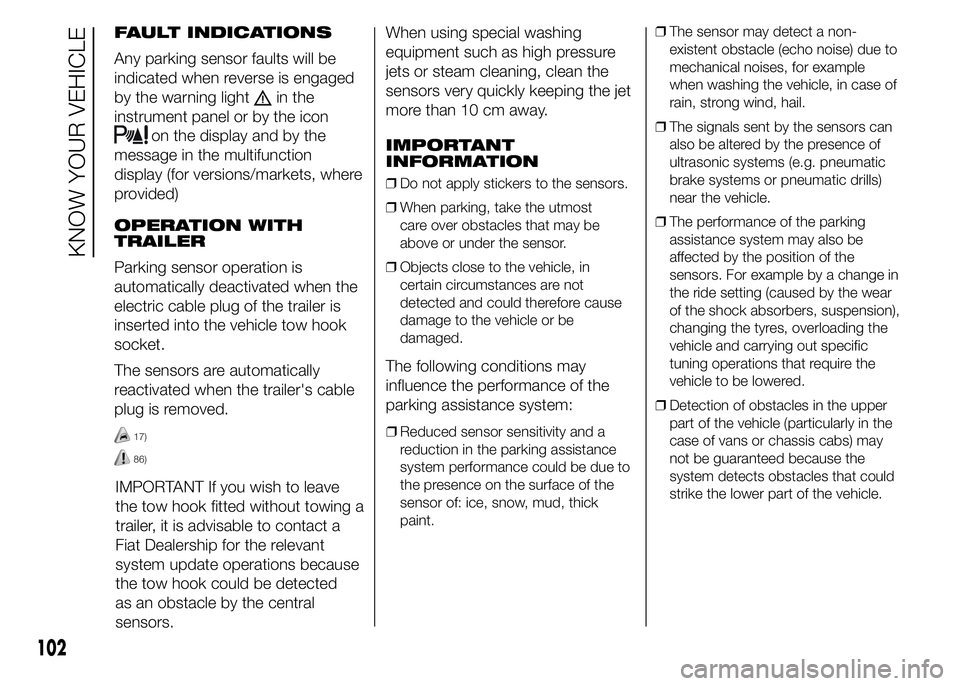
FAULT INDICATIONS
Any parking sensor faults will be
indicated when reverse is engaged
by the warning light
in the
instrument panel or by the icon
on the display and by the
message in the multifunction
display (for versions/markets, where
provided)
OPERATION WITH
TRAILER
Parking sensor operation is
automatically deactivated when the
electric cable plug of the trailer is
inserted into the vehicle tow hook
socket.
The sensors are automatically
reactivated when the trailer's cable
plug is removed.
17)
86)
IMPORTANT If you wish to leave
the tow hook fitted without towing a
trailer, it is advisable to contact a
Fiat Dealership for the relevant
system update operations because
the tow hook could be detected
as an obstacle by the central
sensors.When using special washing
equipment such as high pressure
jets or steam cleaning, clean the
sensors very quickly keeping the jet
more than 10 cm away.
IMPORTANT
INFORMATION
❒Do not apply stickers to the sensors.
❒When parking, take the utmost
care over obstacles that may be
above or under the sensor.
❒Objects close to the vehicle, in
certain circumstances are not
detected and could therefore cause
damage to the vehicle or be
damaged.
The following conditions may
influence the performance of the
parking assistance system:
❒Reduced sensor sensitivity and a
reduction in the parking assistance
system performance could be due to
the presence on the surface of the
sensor of: ice, snow, mud, thick
paint.❒The sensor may detect a non-
existent obstacle (echo noise) due to
mechanical noises, for example
when washing the vehicle, in case of
rain, strong wind, hail.
❒The signals sent by the sensors can
also be altered by the presence of
ultrasonic systems (e.g. pneumatic
brake systems or pneumatic drills)
near the vehicle.
❒The performance of the parking
assistance system may also be
affected by the position of the
sensors. For example by a change in
the ride setting (caused by the wear
of the shock absorbers, suspension),
changing the tyres, overloading the
vehicle and carrying out specific
tuning operations that require the
vehicle to be lowered.
❒Detection of obstacles in the upper
part of the vehicle (particularly in the
case of vans or chassis cabs) may
not be guaranteed because the
system detects obstacles that could
strike the lower part of the vehicle.
102
KNOW YOUR VEHICLE
Page 117 of 367

KNOWING THE INSTRUMENT PANEL
This section of the booklet gives
you all the information you need to
understand, interpret and use
the instrument panel correctly.CONTROL PANEL AND
INSTRUMENTS ...............................114
DISPLAY ........................................120
TRIP COMPUTER ...........................129
WARNING LIGHTS AND
MESSAGES ....................................132
- LOW BRAKE FLUID/HANDBRAKE
ENGAGED .......................................... 132
- EBD FAILURE .................................. 133
- AIRBAG FAILURE ............................. 133
- SEAT BELTS NOT FASTENED .......... 134
- ENGINE COOLANT TEMPERATURE
TOO HIGH .......................................... 135
- LOW BATTERY CHARGE ................. 135
- LOW ENGINE OIL PRESSURE ......... 136
-ENGINE OIL DETERIORATED ........... 136
-INCOMPLETE DOOR/LOAD
COMPARTMENT CLOSURE ............... 137
- POWER STEERING FAILURE ........... 137
-SELF-LEVELLING SUSPENSION
FAILURE ............................................. 137
- INJECTION/EOBD SYSTEM
FAILURE ............................................. 139
- ABS FAILURE ................................... 140
-FUEL RESERVE ................................ 140
- GLOW PLUG HEATING/GLOW
PLUG HEATING FAILURE ................... 141
- WATER IN DIESEL FILTER ................ 141
-VEHICLE PROTECTION SYSTEM
FAILURE - FIAT CODE ........................ 142
- REAR FOG LIGHTS .......................... 142
-GENERIC FAILURE INDICATION ....... 142
-DPF (PARTICULATE FILTER)
CLEANING UNDERWAY ..................... 144
-WORN BRAKE PADS ........................ 145
-DRIVING ADVISOR ........................... 146
- TPMS ............................................... 147
- DIPPED HEADLIGHTS ..................... 148- FOLLOW ME HOME ........................ 148
- LEFT-HAND DIRECTION INDICATOR
............................................................ 148
- RIGHT-HAND DIRECTION
INDICATOR ........................................ 149
-FOG LIGHTS ..................................... 149
- CRUISE CONTROL .......................... 149
-SPEED LIMITER ................................ 149
- AUTOMATIC MAIN BEAM
HEADLIGHTS ..................................... 150
- MAIN BEAM HEADLIGHTS .............. 150
-EXTERIOR LIGHTS FAULT ................ 151
-BRAKE LIGHT FAILURE .................... 151
-MAIN BEAM AUTOMATISM FAULT ... 152
-POSSIBLE ICE ON ROAD ................. 152
-SPEED LIMIT EXCEEDED ................. 152
-SCHEDULED SERVICING ................. 152
-DRIVING ADVISOR SYSTEM
FAILURE ............................................. 153
-TRAFFIC SIGN RECOGNITION
FAILURE ............................................. 153
-LIMITED RANGE ............................... 153
-START&STOP SYSTEM
ACTIVATION/DEACTIVATION .............. 154
-START&STOP FAILURE .................... 154
113
Page 141 of 367

Warning lights on
displayWhat it means What to do
redINCOMPLETE DOOR/LOAD COMPARTMENT CLOSURE
On certain versions the warning light switches on when one or more
doors or the load compartment are not completely shut.
On some versions, the display shows a dedicated message that indicates
left/right front door or rear/load compartment door opening.
A buzzer will sound when doors/tailgate are open and the vehicle is
moving.
Warning lights on
panelWhat it means What to do
redPOWER STEERING FAILURE
When the ignition key is turned to MAR-ON the
warning light on the dial turns on, but it should
turn off after a few seconds.
If the warning light stays on together with the
message shown on the display and a buzzer, the
power steering is ineffective and the effort on the
steering wheel increases significantly even though
the vehicle can be steered.Contact a Fiat Dealership.
redSELF-LEVELLING SUSPENSION FAILURE
(for versions/markets, where provided)
The warning light comes on when the ignition key
is turned to MAR-ON, but it should switch off
after a few seconds.
The warning light switches on when a fault is
present in the self-levelling suspension system.
137
Page 186 of 367
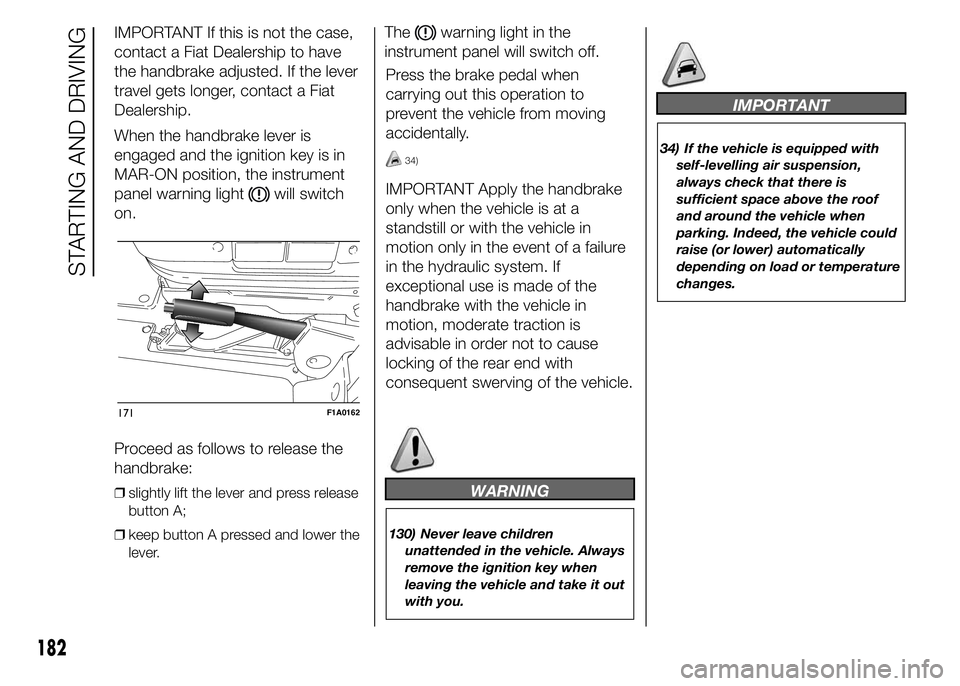
IMPORTANT If this is not the case,
contact a Fiat Dealership to have
the handbrake adjusted. If the lever
travel gets longer, contact a Fiat
Dealership.
When the handbrake lever is
engaged and the ignition key is in
MAR-ON position, the instrument
panel warning light
will switch
on.
Proceed as follows to release the
handbrake:
❒slightly lift the lever and press release
button A;
❒keep button A pressed and lower the
lever.
Thewarning light in the
instrument panel will switch off.
Press the brake pedal when
carrying out this operation to
prevent the vehicle from moving
accidentally.
34)
IMPORTANT Apply the handbrake
only when the vehicle is at a
standstill or with the vehicle in
motion only in the event of a failure
in the hydraulic system. If
exceptional use is made of the
handbrake with the vehicle in
motion, moderate traction is
advisable in order not to cause
locking of the rear end with
consequent swerving of the vehicle.
WARNING
130) Never leave children
unattended in the vehicle. Always
remove the ignition key when
leaving the vehicle and take it out
with you.
IMPORTANT
34) If the vehicle is equipped with
self-levelling air suspension,
always check that there is
sufficient space above the roof
and around the vehicle when
parking. Indeed, the vehicle could
raise (or lower) automatically
depending on load or temperature
changes.
171F1A0162
182
STARTING AND DRIVING
Page 204 of 367

❒turn the ring nut to partly extend the
jack;
❒arrange the jack near the lift support
closest to the wheel to be replaced
at the points shown in fig. 180.
For short wheelbase versions with
retractable footboard, the jack must
be positioned at the lift point shown
in fig. 182 aligned (45°) so that it
does not interfere with the retractable
footboard;
❒warn all bystanders that the vehicle is
about to be lifted. They must stay
clear and not touch the vehicle until it
is back on the ground.❒for versions equipped with
self-levelling air suspension, before
raising the vehicle with the jack,
press buttons A and B fig. 183
simultaneously for at least 5 seconds.
The operating mode for raising the
vehicle is activated: the LEDs on the
buttons come on constantly. To
exit this mode, press buttons A and
B simultaneously for another 5
seconds; both LEDs on the buttons
will go out and full system operation
will be restored. This mode
deactivates automatically when the
speed of approx. 5 km/h is
exceeded.
147)
❒lift the vehicle.
After lifting the vehicle:
❒for all versions, when gaining access
through the vehicle's right rear wheel
arch, adjust the screw A fig. 184
for the spare wheel retaining device,
using the spanner provided and
correctly assembled, with the
dedicated extension Bfig. 184;
❒turn tool C anticlockwise fig. 185 to
allow the spare wheel to be lowered;
❒continue turning anticlockwise until
the stop point, indicated by the
stiffening of the manoeuvre or a click
from the clutch present in the device;
148) 149)
❒after unwinding the whole cable of
the spare wheel lifting device, remove
the wheel from the vehicle;
❒unscrew the retaining knob D fig. 186
and release the wheel releasing the
support E.
182F1A0169
183F1A0170
184F1A0171
200
IN AN EMERGENCY
Page 207 of 367
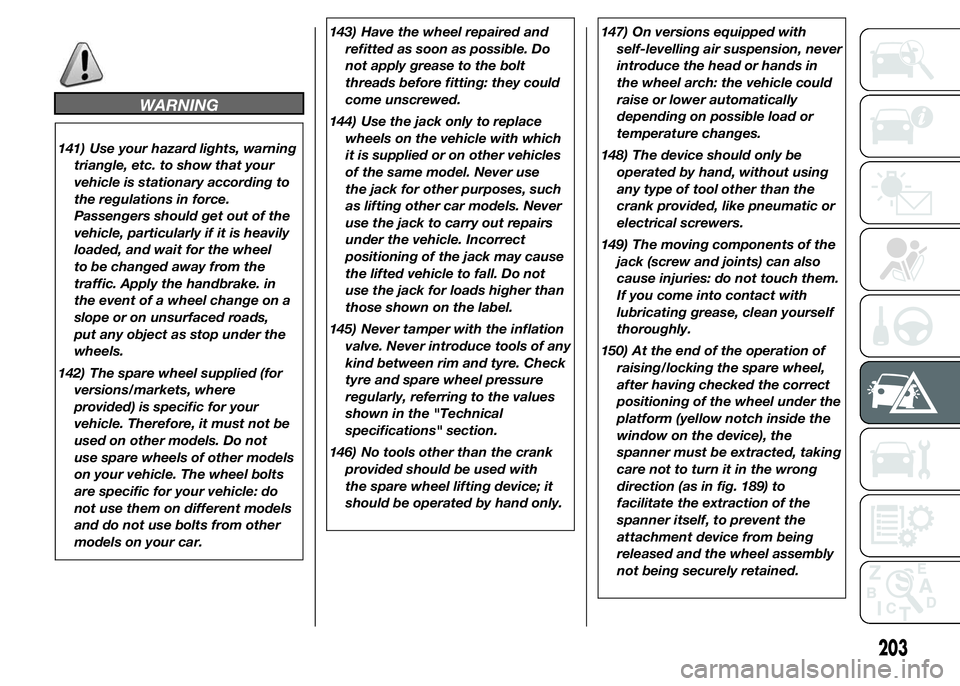
WARNING
141) Use your hazard lights, warning
triangle, etc. to show that your
vehicle is stationary according to
the regulations in force.
Passengers should get out of the
vehicle, particularly if it is heavily
loaded, and wait for the wheel
to be changed away from the
traffic. Apply the handbrake. in
the event of a wheel change on a
slope or on unsurfaced roads,
put any object as stop under the
wheels.
142) The spare wheel supplied (for
versions/markets, where
provided) is specific for your
vehicle. Therefore, it must not be
used on other models. Do not
use spare wheels of other models
on your vehicle. The wheel bolts
are specific for your vehicle: do
not use them on different models
and do not use bolts from other
models on your car.143) Have the wheel repaired and
refitted as soon as possible. Do
not apply grease to the bolt
threads before fitting: they could
come unscrewed.
144) Use the jack only to replace
wheels on the vehicle with which
it is supplied or on other vehicles
of the same model. Never use
the jack for other purposes, such
as lifting other car models. Never
use the jack to carry out repairs
under the vehicle. Incorrect
positioning of the jack may cause
the lifted vehicle to fall. Do not
use the jack for loads higher than
those shown on the label.
145) Never tamper with the inflation
valve. Never introduce tools of any
kind between rim and tyre. Check
tyre and spare wheel pressure
regularly, referring to the values
shown in the "Technical
specifications" section.
146) No tools other than the crank
provided should be used with
the spare wheel lifting device; it
should be operated by hand only.147) On versions equipped with
self-levelling air suspension, never
introduce the head or hands in
the wheel arch: the vehicle could
raise or lower automatically
depending on possible load or
temperature changes.
148) The device should only be
operated by hand, without using
any type of tool other than the
crank provided, like pneumatic or
electrical screwers.
149) The moving components of the
jack (screw and joints) can also
cause injuries: do not touch them.
If you come into contact with
lubricating grease, clean yourself
thoroughly.
150) At the end of the operation of
raising/locking the spare wheel,
after having checked the correct
positioning of the wheel under the
platform (yellow notch inside the
window on the device), the
spanner must be extracted, taking
care not to turn it in the wrong
direction (as in fig. 189) to
facilitate the extraction of the
spanner itself, to prevent the
attachment device from being
released and the wheel assembly
not being securely retained.
203